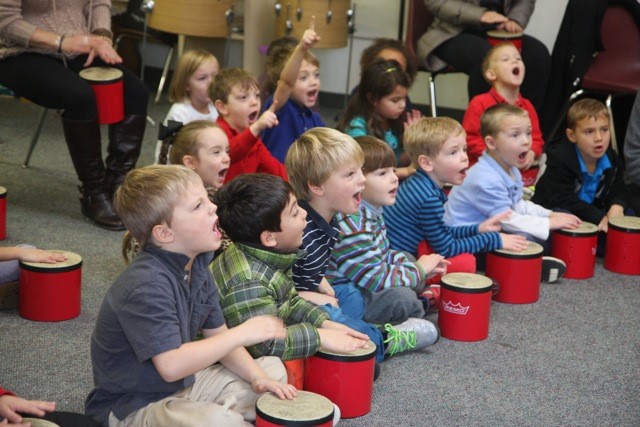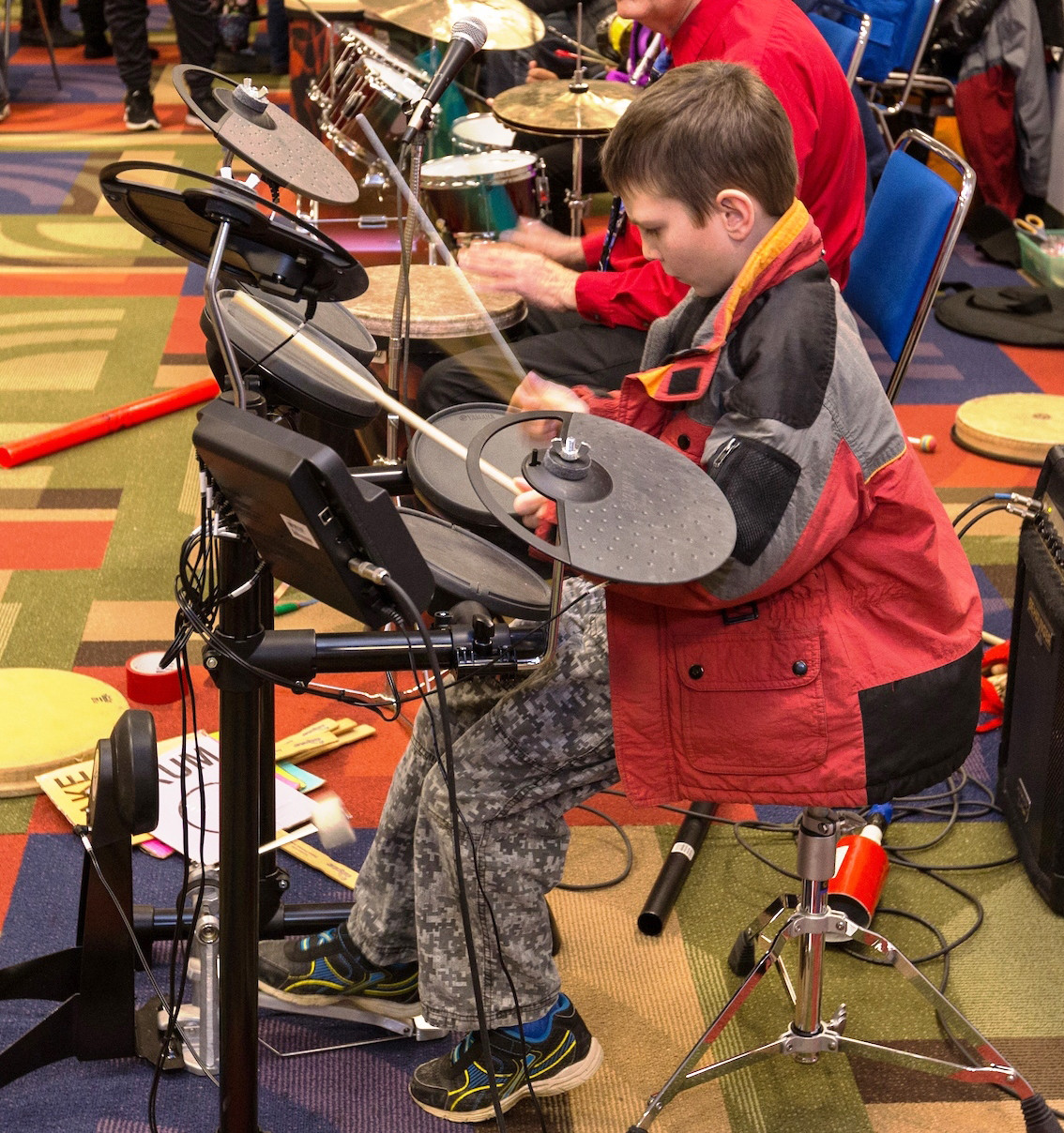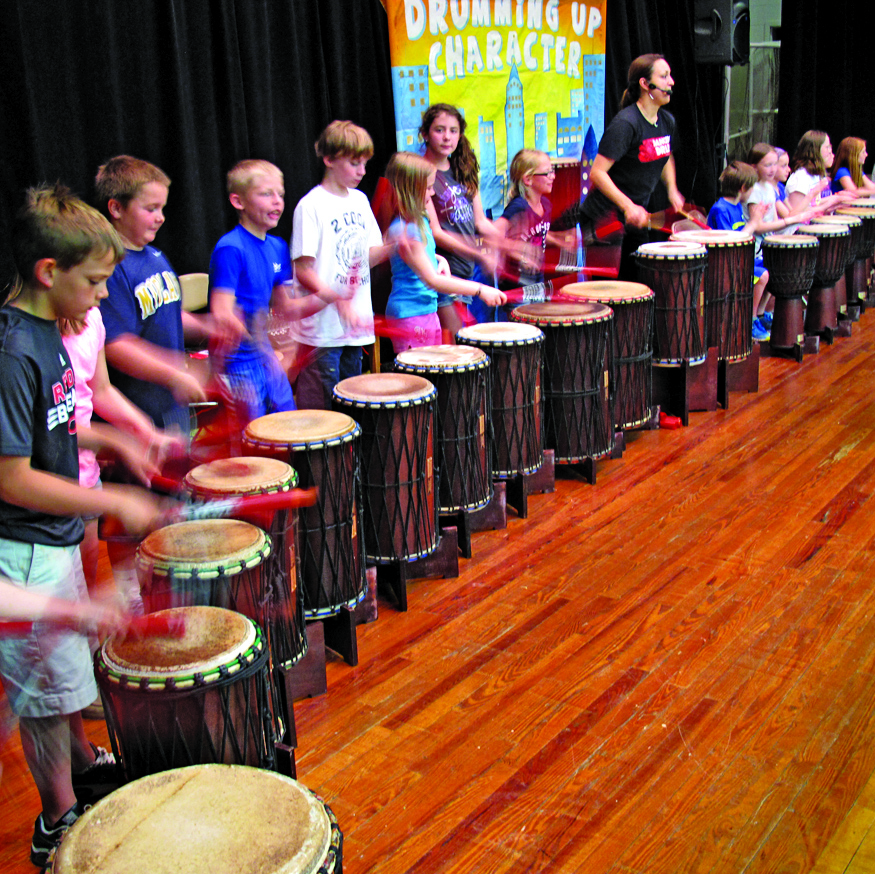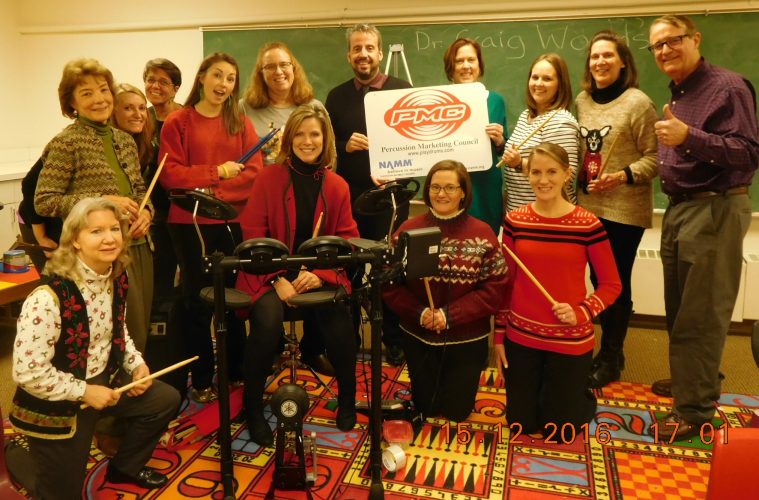A “canary in a coal mine.” The idiom means something or someone who acts as an early indicator and early warning of possible adverse conditions or danger. Years ago, some thought the advent of the electronic drum set was a canary in a coal mine, predicting the death of acoustic drum sets. But something else has happened.
“Electronic drum sets were once thought of as the destruction of acoustic drum sets,” Percussion Marketing Council (PMC) co-executive director, Karl Dustman, told the Music & Sound Retailer. “But it is really growing the number of players.”
Dustman explained that acoustic drummers continue to enjoy their instruments and hone their craft. But electronic drummers are rapidly joining the fray as perceived “noise” becomes less of a problem, making drumming an acceptable activity in garages, bedrooms and perhaps even living rooms.
“Any retailer cannot afford to ignore this,” stressed Dustman. “It’s doubling the opportunity for drummers.”
Jules Tabberer-Stewart, global strategic product marketing manager — drums, Roland Corp., and Pat Kennedy, product manager, drums and percussion, Roland Corp. U.S., agree with the sentiment that electronic drumming is adding new drummers, as opposed to simply converting acoustic players. “As a former middle school band director, I can say with confidence that the use and incorporation of technology helps to drive the desire to play and practice music,” said Kennedy. “Having access to an instrument that can help coach you along the way and connect to phones, tablets, laptops and the like creates a pathway into music that may have otherwise gone unexplored. A common barrier for many new players is often the self-conscience aspect of having others hear you while you are learning. Although it is very important to have professional guidance and knowledge along the way, electronic drums allow students of all ages and abilities to develop skills and musical concepts with the comfort of personal space and aural freedom.”
“Yes, I do agree [with this statement],” affirmed Tabberer-Stewart. “Without question, the electronic drum kit has opened up the possibility for younger players and families to give drumming a try. When I was learning drums, I was fortunate enough to have a family (and neighbors) who were tolerant enough to hear me play acoustic drums each day. But that’s not the case for a lot of people. In the mid-1990s, when I was learning to play, electronic drums were just too alien and too expensive to even consider. I have personally met a lot of parents that were not aware of electronic drums, or that they were a viable alternative to acoustic drums, and I’ve met many young players and drum students who began their journey on electronic drums. The fact that today’s electronic drums don’t produce a loud ‘acoustic’ noise and can be played on headphones has certainly opened up the opportunity to new drummers who previously may have had to write the idea off.”
But then there is the question of whether electronic drumming will continue to grow, as opposed to enjoying growth and plateauing. A consortium of PMC executives, namely Yamaha Corp. of America’s Dave Jewell, Hal Leonard’s Brad Smith, Alfred Music’s Jennifer Paisley-Schuch and Sabian’s Stacey Montgomery-Clark, flat out said growth of electronic drumming is sustainable. “Absolutely this can continue, and PMC can help drive this expansion of the percussion market. We have found that electronic drums are a great entry into the drumming world because of the smaller area it takes to set up and the silent aspect of playing an electronic kit. Also, the internal features to help a drummer play in time and learn different styles are vast. However, we find when that drummer wants to join a band and play some gigs, they go out a buy an acoustic drum set. We can almost say we are very much like a guitar player. I would say 95 percent of the guitar players that have an electric guitar also have an acoustic guitar,” the executives said in a joint statement prepared for the Retailer.
Many components are currently driving the growth of electronic percussion, relayed Steven Fisher, director of drums and percussion, Yamaha Corp. of America. “There are less expensive options that lower the barrier of entry, new advances and technologies to make electronic drum products easier to use and the general awareness of the various applications such as education, practice, recording and performing,” he said. “There will always be new technologies that will give drummers new sonic choices and applications, as well as growth, from the awareness for anyone that wants to enjoy drumming that is faced with the challenge of noise restrictions.”
Going back to the 1970s, there were drummers and percussionists who recognized that electronic drums have a different sound character, which could be used to complement their traditional acoustic instruments to broaden their sound palette, added Tabberer-Stewart.
“Ever since that time, music has evolved to increasingly incorporate electronic percussion elements. Just look at today’s diverse music genres, and a lot of them feature electronic percussion sounds. So, I think progression in music and the evolution of new music styles is helping to drive the popularity of electronic drum sounds for sure, and electronic drum pads such as the SPD-SX are a common instrument on stages everywhere today as a result. A lot of today’s drummers are expected to play and know how to use a hybrid drum kit, comprising traditional acoustic drums and cymbals with electronic drum pads. Hybrid drumming in general is a sub-category that is seeing growth within the wider music industry.
“Parallel to that, electronic drums have moved on hugely since their beginnings,” he continued. “Play an original electronic kit from the ‘80s and compare that with today’s TD-50 V-Drums, and you’ll see the evolution is as obvious as the ‘80s cell phone compared to the smart phones of today. Because our V-Drums are that much more playable and expressive, even compared with the V-Drums we produced 10 years ago, they are becoming more acceptable to play while offering the obvious benefit of quiet practice in the home/residential environment.”
Kennedy added the following to Tabberer-Stewart’s comments: “Another driving factor of the growth in electronic drumming is that it allows drummers to brand themselves as a more marketable musician. As Jules stated, electronic drum sounds are heard everywhere in today’s music, spanning all genres and styles. Drummers must have the knowledge, access and confidence to use electronics to create the most musical interpretation and expression that is demanded within the music industry. This same adage also applies to non-drummers, such as vocalists, keyboardists, or even guitar/bass players, who want to spice up their setup with a drum pad or sampling pad. The encouragement of all musicians — drummers in particular — to embrace electronics, and to apply them in an organic, musical way, continues to be a driving force behind this growth.”
 Young Americans
Young Americans
Accessibility for students to electronic drums is another important piece of the puzzle. The PMC’s Drum Set in the Classroom (DSC) program has presented workshops and assemblies to hundreds of teachers and thousands of students throughout the school year, Craig Woodson, Ph.D., owner, Ethnomusic Inc. and Roots of Rhythm, told the Retailer. “Over the past two years, the PMC has been integrating the introduction and classroom use of electronic drum kits into what started as only an acoustic drum set program,” he said. “While most schools and classrooms might have some acoustic hand percussion instruments, this newer electronic complete drum set technology is always exciting and enthusiastically received by both students and teachers. For many, this is a positive first drumming experience that ignites the interest in drums and drumming. Very often, we have found that a teacher or other workshop-classroom program attendee has seen and heard electronic drum kits through other family and friends.”
Students are reacting positively to electronic drum products, Dr. Woodson added. “Wherever DSC programs are presented using an electronic kit, it becomes obvious that the instrument, with its varied drum and percussion sounds available, has tremendous appeal to students. In the same way that acoustic pianos and guitars have become classroom fixtures over the years, the future is bringing electronic musical instruments — specifically drum sets — into regular classroom use. The more classroom teachers experience the creative and self-expression fun of drumming, the more electronic drum sets will start appearing in school applications.
“Whether played through a speaker or through headphones, students are always amazed at the variety of sounds the electronic drum kit can produce and the compact nature of the instrument,” continued Dr. Woodson. “Most electronic kits provide a wide variety of play-along tracks as well as self-recording applications, all of which have been very helpful in creating a positive performance experience for each student. Typical of enthusiastic students waiting to play the kit are comments like, ‘Can I get back in line for another turn?’ or ‘How much does this drum set cost?’”
Lindsay Rust, managing director for Dancing Drum and a program facilitator of PMC’s Percussion in the Schools in New Orleans, added that she works mostly at the elementary school level, while electronic drum sets appear mostly in high schools. However, she did note that “There may be some interesting possibilities for app development where students can use iPads as an electronic drum.”
Bob Bloom of Drumming About You, a “Master Teaching Artist” who leads arts integration and interactive-drumming programs for students in grades pre-kindergarten to 12, added that, in his many conservations with teachers, students ask to play percussion products in schools. However, he acknowledged that setup time, storage space, durability and transportation for any drum set are critical issues for many teachers that may impede sales for MI retailers. To solve this problem, “What about a kit(s) that incorporates the electrical contacts for the triggers into the racks, stands and mounts? This would eliminate the need for wiring. Setup, teardown and I’d also make rack heights and widths adjustable to accommodate a range of grade levels, and to be accessible to kids with disabilities.”
Dr. Woodson noted that some stereotypes still exist in schools, for which he hopes electronic drums can present a solution. “In general, students like and enjoy playing percussion instruments, probably for how quickly everyone can begin music-making,” he said. “Rhythmic expression is a basic impulse to all humans and I often find that students already playing other instruments either had seriously considered percussion at the beginning of the instrument selection process or would like to go back to playing drums. Electronic percussion seems to help make that re-connection to the fun and creativity of drumming. Some teachers say they played drums or a percussion instrument in their youth and would now like to get back to it. Others say they have some form of drums at home and play them regularly for relaxation. Unfortunately, I have experienced a few music teachers discouraging young girls from playing drums, indicating that they should be playing traditional ‘girl instruments,’ like flute, violin or clarinet. I believe electronic drums will help make playing percussion accessible to all populations without any stereotypes.”

Benefits of Drumming
Whether it’s with an electronic drum set or acoustic drum set, Rust stressed the importance of drumming, because it is not only about making music. “It’s also a medium through which students can work together to build school community, learn to focus in a dynamic environment and enjoy creative self-expression,” she said. “Dancing Drum aims to create a positive community of respect, where students are exposed to other cultures and connected to their own. Music is so important for kindergarten to eighth-grade students, and Dancing Drum enables them to make music with their peers that sounds great, builds listening and performing skills, and inspires them to participate at their highest level of ability,” she said. “As students experience success through drumming, the boost of confidence that they feel in music class can carry throughout the entire school day. A large majority of students perceive drumming as cool, and it’s an activity that they thoroughly enjoy. As teachers, we can use the engagement piece of drumming as a ‘hook’ to get kids interested in all kinds of other subjects: math, language arts, social studies, geography, history and more.”
Added Bloom: “Students benefit from the characteristics of arts-integration [and] interactive drumming (ID) that contribute to their grade-to-grade advancement, grow their interpersonal and intrapersonal skills, and support their workplace readiness. A primary paradigm of education is to build and nurture the skills of the ‘4 Cs’: communication, collaboration, critical thinking and creativity. ID is a great medium to support this paradigm. ID is enticing and accessible when led with attention to the challenges of people with cognitive, physical and multiple disabilities. The products that I currently provide to consumers to play in arts-integration presentations are: Hand drums, shakers, castanets, paint buckets and implements, adaptive equipment, scarves.”
There are several physical advantages of playing a drum set, noted Dr. Woodson. “1. The drum kit creates an experience working in a large three-dimensional space. Other instruments are primarily linear (piano, clarinet, trumpet). 2. The drum set requires and builds extensive four-way coordination for both hands and feet. 3. With hand drums, the wide variety of sounds are produced simply by how and where you strike the head. 4. The percussion player needs to make extensive use of peripheral vision, like multiple drums and cymbals in drum sets, and is a requirement for playing mallet keyboard percussion instruments like vibes, marimba, etc.
“… When playing a percussion instrument, students go through the cognitive process of integrating rhythmic patterns in real time, especially with the play-along tracks provided within the electronic kits,” he continued.
Regarding the overall state of the drum market, things are robust, Fisher told the Retailer. “Increasing interest and awareness to attract more players is very important to continue the growth of our business. More manufacturers need to participate in this endeavor with organizations such as the PMC that can help make a difference. We are also fortunate that drums and percussion as a product category are not ‘fixed’ instruments and are always evolving. Drummers are always looking for new and innovative products that inspire them to create new sounds [and] applications and [to] musically express themselves,” he said.
The proof is in the numbers, relayed Tabberer-Stewart. “For sure, sales data points to continued growth in the electronic drum and percussion product market. New brands and product entering the market has also helped to see growth in the electronic percussion sector. At Roland, we’ve seen continued growth in the electronic drum business and have remained a market leader, which we’re delighted to see, as it means we’re continuing to succeed in our mission to help new and existing drummers enjoy the creativity of playing the instrument and making music, every day. Products such as the TD-17 Series V-Drums, which we launched in May 2018, have seen very strong sales, and I do think it has helped to convince many drummers, particularly those previously skeptical about electronic drums, to give them a try. The TD-1DMK that we launched just one year ago in September 2018 has had tremendous success, initially as a festive-season best-seller in 2018, but actually the sales demand has sustained throughout 2019. That particular product is really aimed at beginners and students, and of course their parents, so I am confident that we’re helping to bring in new customers into retailers, which is healthy for the industry.
“I hear anecdotally from retailers that electronic drum sales today outweigh acoustic sales, at least on a quantity basis,” continued Tabberer-Stewart. “I hear too that acoustic drum and percussion instrument sales have been more of a challenge in recent years, but then, I also hear that trends in high-end and mid-range acoustic drums are strong. While the growth in electronic drum sales has increased and the knock-on effect may well place a squeeze on the growth in the acoustic sector, I do think that, overall, the growth in electronic drum sales can bring new blood into the world of drums. I don’t necessarily see that someone who starts out on electronic drums won’t progress to play and buy acoustic drums eventually, leading to a sale of acoustic drums along the line. Roland’s intention is not to reduce or take share from acoustic drums either; our V-Drums are just another way to access the instrument. If we can help to grow the drums and percussion business overall, that is surely good for everyone.”
“Fortunately, the data shows that electronic drums are a growing sector of the overall percussion market. Much of this positivity can be attributed to the values and benefits mentioned in our [aforementioned comments], while also factoring in advances in technology which pushes these instruments to do more and more,” affirmed Kennedy. “The future holds many exciting possibilities for electronic drums, and Roland will continue to open doors and forge new paths to offer access for anyone interested in enjoying the world of music.”
 2020 Foresight
2020 Foresight
The percussion industry should receive an additional boost as we approach 2020. Next year, PMC will present plenty of firepower to advocate for drummers and drumming as the organization celebrates 25 years. Expect plenty of events during the year-long celebration. “At the very core of the PMC’s mission is the determination to bring drums and drumming to the center of the general public while making percussion accessible to everyone … a lifestyle. By presenting playing drums as a positive educational fun recreation, percussion retailers have benefited from this market growth, whether they realize it or not. This dedication for creating more players goes out to capture the attention and interest of every current non-player and provide a positive drumming experience. Once this is achieved, the public wants more and will gravitate to the retailer for assistance, advice and guidance in getting started,” the trade group stated.
The year-long celebration will commence with a party at the 2020 NAMM Show on Jan. 16, beginning at 6:30 p.m. Look for more details to be revealed about this shortly.
In addition, the PMC will have monthly online contests where consumers can enter for 12 free drum lessons, from the contestant’s favorite local drum or music store retailer that offers studio private lessons. The contest, whose slogan is “Get Your Sticks Together,” will provide lessons that are valued at $30 each and paid for by the PMC. A randomly selected winner is drawn for 12 months of 2020 (January through December), with a promotion at year’s end recognizing the 12 winners and participating percussion retailers. There are no age restrictions/criteria for winning this package.
And the PMC’s 25th anniversary will really kick into high gear in May 2020 during International Drum Month, during which the PMC will sponsor a free celebrity drum lesson contest carrying the slogan “Take It From the Master.” The randomly selected winner will receive a one-hour online live video drum lesson from an assortment of pre-determined, highly recognized international drummer-artists. The one-hour video drum lesson will be arranged within 30 days of winner selection. There is no age requirement or limitation in the consumer entry form.
The PMC’s 25th anniversary celebration during International Drum Month will also include an online consumer entry contest for a one-of-kind commemorative percussion product donated by participating PMC member firms. For consideration, entrants must be over 18 years old and submit an entry to indicate their name, address, phone number and contact person for his/her local percussion retailer.
These special contests and events are in addition to ongoing PMC programs, including Percussion in the Schools, Drum Set in the Classroom, Drums Across America, March to Your Own Drum and Hand Drumming for Life.
But what are the PMC executives most excited about next year? “I think this really comes back to the fundamentals and following our mission of the PMC,” concluded the PMC executive consortium. “The PMC’s mission is to provide professional marketing and advertising campaigns, programs and activities that bring increased public awareness to drumming, thus increasing the number of people playing all types of drums. With this in mind, and always trying to find programs that will involve our dealers and create new players, we are looking forward to our ‘Take It From the Master’ program. In addition, we will offer one lucky winner each month in 2020 the chance to win 12 free drum lessons from their local dealer. These new initiatives will help us celebrate our 25 years of growing the percussion industry.”


